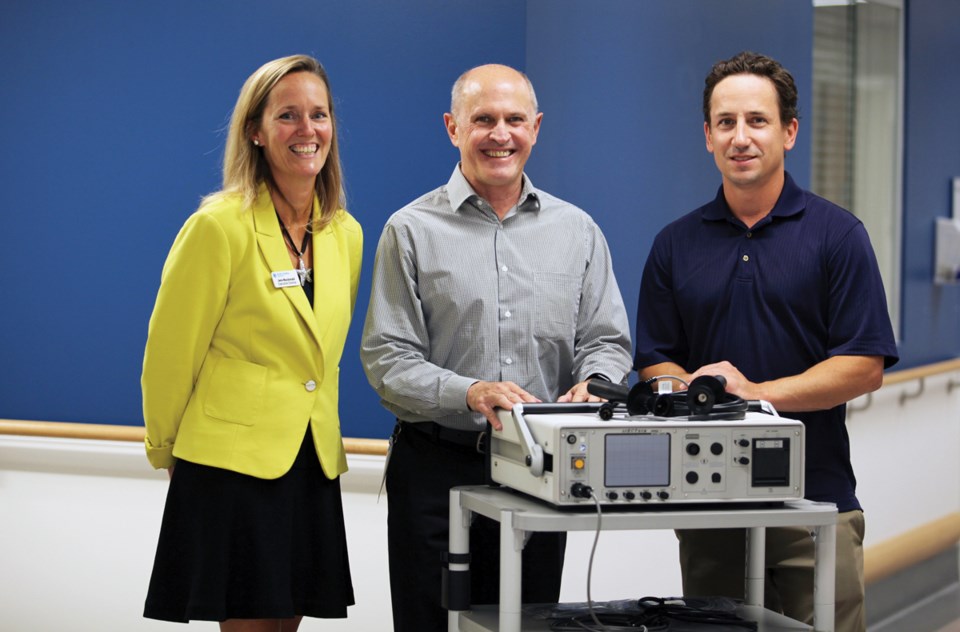More Sunshine Coast residents suffering from severe depression or Parkinson’s disease are expected to receive electroconvulsive therapy (ECT) treatments after Sechelt Hospital acquired an ECT unit last month.
“There will be a bit of an uptick because we have an elderly population,” said Dr. Anthony Barale, a consulting psychiatrist and medical manager for Sunshine Coast Mental Health.
The number of local patients treated, however, will continue to be low.
“I imagine we would be doing two to four patients a month, at the most,” Barale said. “Each patient will get anywhere from six to 12 treatments, depending on how they respond.” Those who respond well may then go on maintenance ECT as outpatients, receiving treatments every third or fourth week.
Until now, most Sunshine Coast patients receiving ECT had to make repeat trips to Vancouver for treatment. “The logistics are very hard, as it is for many of our medical procedures for our coastal people. So it will be a great boon to people who won’t have to travel back and forth, and [bear] the cost of it as well,” Barale said.
ECT – formerly known as electroshock therapy and commonly called shock treatment – has a controversial history and still has its critics, as an investigative report in The Tyee recently documented.
Barale acknowledges the treatment is “controversial in that it comes from a poor start in its career,” when no anesthetic or muscle relaxants were used, “which was clearly barbaric with hindsight.” However, “rather like surgery, which was done without anesthesia once upon a time, it has morphed into a much more acceptable and much better controlled procedure with minimal side effects.”
An average of about 10,000 ECT procedures are done each year in B.C. During the treatment, Barale said, “a very tiny pulse of electricity – equal to the amount of power in a 60-watt bulb for one second – is passed through the brain,” stimulating the neurotransmitters responsible for mood and thinking.
“If the patient is well selected, the benefits greatly outweigh the risks. There’s never zero risk with anything. But we’ve controlled and worked to eliminate the risks over the decades and with improved machines and improved anesthesia, the risks have gone down quite dramatically in the last 15 to 20 years.”
What critics lose sight of, Barale said, “is that we reserve ECT for very severe depression, which is life-threatening. So ECT is a life-saving procedure, either in terms of preventing suicide in severe depression or in terms of the sort of depression which most people are not familiar with … in which people are not eating and not drinking and they’re just dying.”
He cites a recent case in which a local woman was sent to Vancouver for ECT because she was suffering from extreme depression and apathy, and not sleeping, eating or drinking.
“She came back very well. So in the old days she would have just died. A hundred years ago, 50 years ago. Then there’s patients with treatment-resistant depression for which medications are not working and who remain actively suicidal…
“It’s not a treatment we go to lightly or easily and we do try all other treatment options first. That has to be emphasized. But there’s also the fact that the elderly do not tolerate medications very well for a whole lot of reasons … so it is a treatment that we tend to use more in the elderly … to help the person emerge from severe depression.”
ECT is also used for some patients with Parkinson’s disease when oral medication has stopped working. “With ECT it treats not just the depression that’s often associated with Parkinson’s but it also treats the Parkinson’s very effectively,” Barale said, adding that it is not a cure but does prolong life and quality of life. “We have a number of patients with severe advanced Parkinson’s on the Coast, once again a function of our aged population, who are getting maintenance ECT” in Vancouver as well as Powell River, where treatment has been available for decades.
One source of concern among critics is involuntary ECT.
“This does happen,” Barale said. “It’s very uncommon to rare, and I’ve been involved in ECT on and off for over 30 years.”
In cases where the patient is non-verbal, consent is sought from a temporary substitute decision maker, usually next of kin or spouse. “We outline to that person the risks and benefits of the procedure. That person could technically say no but they very rarely do. So that’s one scenario in which the patients themselves are not directly consenting because … they may not be cognitively capable of doing so.
“There’s another very rare scenario in which people with severe mania that is not responding to medications require ECT and these patients have absolutely no insight into their mania. Once again we would always involve family or next of kin as far as possible in making the decision, but I can count on two hands the number of times I’ve had to do that in over 30 years.”
When ECT is used, Barale said it’s generally a team decision and always with at least two doctors involved. “So there are safety nets, if you like, that some rogue doctor’s not going to suddenly be doing dozens of ECTs.”
The ECT suite was purchased with $17,500 donated to the Sechelt Hospital Foundation by the Barnes family and Dr. Brian Nelson, in memory of Kathleen Archibald, who received palliative care at Sechelt Hospital.
“We wanted to give back,” Nelson said. “I’ve been working here four years and the community has supported me. Andrew [Barnes] was very impressed with the care his mom received at the hospital, so it worked out well for the both of us.”
The ECT suite will be set up in the current post-anesthesia space near the hospital OR and is expected to be in service later this month.



